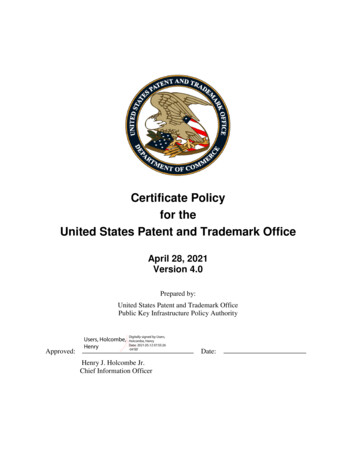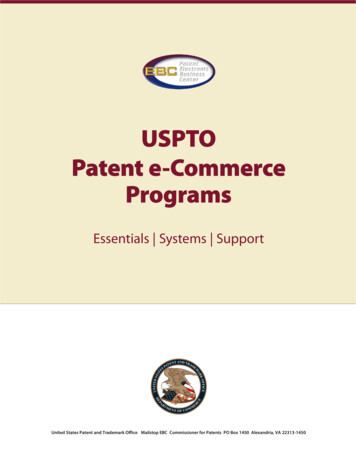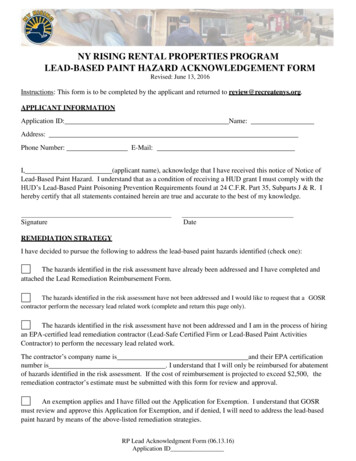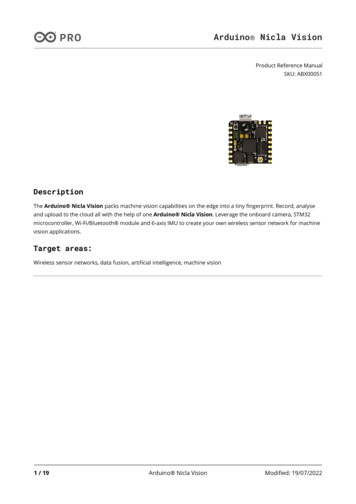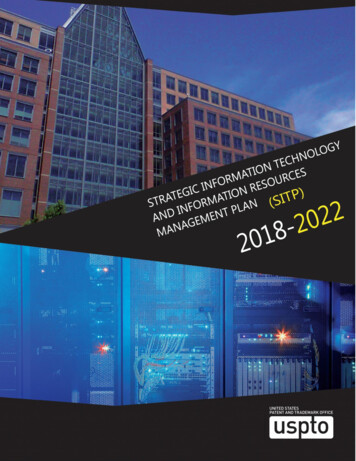
Transcription
United States Patent and Trademark OfficeUSPTO Vision“Lead the nation and the world in intellectual property protection and policy”IT Vision“Transform the USPTO with next generation technology and services”OCIO Mission“Deliver information and technology to enable innovation”
Message from the USPTO Chief Information OfficerI arrived at the USPTO in early 2019 at an exciting time for USPTO’sInformation Technology and Information Resources Management(IT/IRM) program. To drive and manage next generation enterpriseIT investments in such a dynamic, fast-paced world is exhilaratingand challenging. Our Strategic IT/IRM Plan (SITP), referred to inOMB Circular A-130 as the Strategic Information ResourcesManagement Plan, outlines the management approach and top ITinitiatives that are critical to achieving our vision, mission, goals andobjectives. This plan is the primary basis for justifying and prioritizingfuture budget requests for IT resources. Like its predecessor, thisstrategic plan outlines our IT agenda and prioritizes the need tooperate more successfully and efficiently. Among the importantagenda items is to leverage IT to enable the agency to maintain current business production andmeet legislative and legal requirements, while we improve and enhance the customer experiencethrough new digital offerings and ecommerce via next generation systems and technologies.At the same time, our progress must be balanced with the need to maintain existing legacy systemsto ensure they continue to add business value to our customers as we implement better, faster andcheaper ways to grant patents and register trademarks. While our plan forward with newtechnologies and methodologies is clear, I have made the decision to carefully take the time toaddress an urgent and important mission to stabilize our existing IT infrastructure through thefollowing focused OCIO strategies:1.2.3.4.Maximize the technical stability of and supportability for our productsIntegrate security into current and emerging technology and servicesMaximize the automation and standardization of our products and servicesMaximize the usage of identity management tools and standardize access controls forproducts5. Maximize the use of new technology solutions through data to solve business problemsDuring these stabilization efforts, we will prioritize and pause some of our current modernizationprojects while we conduct more research and make adjustments for the remaining FY19 projects. Wewill also be looking at FY20 and FY21 planning efforts, and take our Agile and DevSecOps practicesfurther to improve operational efficiency in close alignment with the business. Throughout thesechanges, it is my goal in my new position is to make our vision a reality by providing an atmospherethat keeps everyone informed, and enables open collaboration for comments, ideas, and concerns.7/17/2019XHenry (Jamie) Holcombe, Jr.USPTO Chief Information OfficerSigned by: Holcombe, Henry1
Table of ContentsUSPTO Strategic Information Technology andInformation Resources Management Plan (SITP)2018 - 2022The 2018 - 2022 USPTO Strategic Information Technology and Information Resources ManagementPlan (SITP) helps govern the USPTO’s IT activities in support of the USPTO 2018 - 2022 Strategic uments/USPTO 2018-2022 Strategic Plan.pdf).This SITP provides a history of IT at the USPTO as well as overall objectives, strategies and goals, anoverview of the USPTO and the OCIO organizations, and an outline of IT strategic managementprocesses. “Where We’ve Been” is a quick review of the history of IT/IRM at the USPTO (pages 3 - 4) Federal and Department of Commerce Objectives (pages 4 - 7) USPTO Mission, Organization and Strategic Goals (pages 7 - 10) USPTO Office of the Chief Information Officer (OCIO) (pages 11 - 15) IT Management Processes of the USPTO (pages 16 - 23) OCIO Strategic Management Process Mapping (pages 24 - 25) Overview of IT Portfolios and Portfolio Goals (pages 26 - 27) The OCIO Business Plan (goals and performance measures on pages 28 - 30) “Where can I find more information?” (page 31)Note: The USPTO implementation of its SITP activities is subject to the availability of resources.2
Where We’ve Been The U.S. Patent and Trademark Office has been a leader ininformation resource management since its inception as one ofthe first federal agencies in 1790. Patent and trademarkapplications, case files and results are retained forever. Ourrecords management dates back to Thomas Jefferson, who storedfiles in his shoeboxes. Patents were filed in cabinets called “shoes”for more than two centuries, until electronic records replacedthem in the 1990s. We were among the first federal agencies to store historical records in bunkersbelow ground, use automation including microfiche and computers, and develop sophisticatedclassification systems. The picture on the right is one of the early Patent Office buildings inWashington DC, which now houses the Smithsonian National Portrait Gallery.The USPTO’s move into its current headquarters in Alexandria, Virginiain 2004 eliminated the need for paper records as we switched toelectronic records. In 2008, the agency created The OCIO Road Mapand Transformation Plan to respond to IT infrastructure issues thatrisked jeopardizing the mission. This plan’s goals were to: (1) stabilizethe existing infrastructure and strengthen the core competencies ofthe IT workforce; (2) consolidate existing infrastructure and applicationsystems to reduce unnecessary duplication; (3) optimize to improve performance; and (4)standardize to facilitate governance, ensure compliance, and maintain and enhance servicesdelivered to customers.In 2013, an independent assessment of the Road Map concluded that the improved governance andmanagement practices and tools were a solid foundation for the major modernization of coreapplication systems. We created the Next Generation Road Map 2014-2018 to guide our continuedtransformation with next generation initiatives to improve the tools provided to our examiners andthe public; i.e., Patents End-to-End (PE2E), Trademark Next Generation (TMNG), and Fee ProcessingNext Generation (FPNG). Also in the plan is an increased emphasis on pace as the OCIO madestrides to increase the speed and velocity of the new tools and services delivered.The seven initiatives in the Next Generation Road Map include: continuous organizationalstrengthening, continuous process improvement, so-called “enterprise-as-a service”,next generationservices; legacy systems, desktop service improvements and enterprise architecture. In addition, thisroadmap set the USPTO technology vision: to provide evolving services that adapt quickly to thegrowing needs of internal and external customers, and leverage technology industry developmentswithin our infrastructure and organization.3
With business growth, technology change, a dispersed workforce and new regional offices openacross the country, the OCIO had to continue to innovate and adapt. We began to adopt Agilemethodologies and DevSecOps practices to gain new efficiencies and instill a culture ofcollaboration, using standardized tools and processes to improve and innovate. The agency iscommitted to continuing to “transform the USPTO with next generation technology and services,”and the OCIO is committed to its mission to “deliver information and technology to enableinnovation” around the clock, across the nation, 24/7/365.Innovation often entails change, and the 2018-2022 USPTO Strategic Information Technology andInformation Resources Management Plan outlines our course of action for continual improvement inthe next four years. However, we will need to balance our plans for innovation with the ongoingneed to maintain the stability and supportability (“future-proofing”) of our existing IT infrastructure.Our mission-first strategy emphasizes a purpose-driven, customer-focused approach fueled bycommunication and business-focused partnerships to improve trust and collaboration, so that theUSPTO can sustain current business production and continue to meet legislative and legalobligations.Federal and Department of Commerce ObjectivesThe President’s ObjectivesThe “President’s Management Agenda to Modernize Government for the 21st Century” identifiesCross-Agency Priority (CAP) goals to target those areas where multiple agencies must collaborate toeffect change and report progress in a manner the public can easily track. This 2018-2022 USPTOSITP maps to the President’s goals and agenda as the USPTO strives to comply with that vision andguidance.4
Office of Management and Budget DirectivesAmong the key federal management directives affecting the USPTO’s IT are the OMB guidance forcompliance with federal legislation such as Executive Order 13800 – Strengthening the Cybersecurityof Federal Networks and Critical Infrastructure, Federal Enterprise Architecture, the E-GovernmentAct of 2002, the Government Paperwork Elimination Act of 1998 (GPEA), the Clinger-Cohen Act of1996, the Federal Acquisition Streamlining Act of 1994, Title V (FASA V), the GovernmentPerformance and Results Act (GPRA) of 1993, and the GPRA Modernization Act of 2010.In addition, OMB closely monitors progress towards compliance with the Federal InformationTechnology Acquisition Reform Act (FITARA), which changed how the federal government buys andmanages computer technology. This act became law in 2015, and includes a provision fordeveloping a streamlined plan for acquisitions and increasing authority of the CIO over all ITprojects. Details about these OMB strategies and directives can be found at the White House website. Here are some OMB initiatives that affect USPTO IT. The “Getting to Green” initiative requires USPTO and other federal agencies to report on theirperformance using a reporting mechanism of red, yellow and green lights. The USPTO nowregularly reports on its IT Investments using five criteria, and strives to achieve a green rating bycollaborating with stakeholders, setting measurable goals, aligning plans with budgets, trackingand managing costs and validating effectiveness. The “Cloud Computing” initiative requires USPTO to take steps to enable convenient, ondemand network access to a shared pool of configurable networks, servers, storage,applications, services, and other computing resources that can be rapidly provisioned andreleased with minimal management effort or service provider interaction. The “Federal Data Center Consolidation” initiative requires USPTO to take steps to migrate fromdedicated data centers to consolidated federal data centers to: (1) promote the use of Green IT,reducing the overall energy and real estate footprint of government data centers; (2) reduce thecost of data center hardware, software and operations; (3) increase the overall IT securityposture of the government; and (4) shift IT investments to more efficient platforms andtechnologies. The “Open Government” directive requires USPTO to establish “a system of transparency, publicparticipation, and collaboration” in order to promote efficiency and effectiveness inGovernment.5
Federal CIO Council ObjectivesEstablished by Executive Order 13011 and later codified by the E-Government Act of 2002, the CIOCouncil is the principal interagency forum for improving agency practices related to the design,acquisition, development, modernization, use, sharing, and performance of Federal informationresources. Council members include CIOs and Deputy CIOs from 28 Federal agencies, including theCIO of the Department of Commerce. The four strategic pillars of this plan are aligned to thepriorities of the current administration, as defined by the CIO Council: IT Modernization. Leverage advances in technology, such as cloud and mobile, to transformhow the USPTO delivers and consumes IT services, and advance the “Digital GovernmentStrategy” to securely design systems for interoperability and openness to unleash the powerof data, and reduce barriers to citizen and business interaction.Cybersecurity. Advance the technical and policy protection capabilities for IT systems in orderto address the continuously changing threats on our cybersecurity defenses. Technology Investment Management. Institute an IT management framework thatimplements a standard IT spend taxonomy. Data. Leverage data as a strategic asset to deliver on mission, serve customers, and stewardresources.Department of Commerce (DOC) ObjectivesThe DOC Strategic Plan includes Objective 1.3 to “Strengthen Intellectual Property Protection” whichdrives the USPTO Strategic Plan. The objectives in the DOC Strategic Plan that affect this SITP are: Strategic Objective 5.2: Accelerate Information Technology Modernization which includesmodernizing and consolidating IT by: (1) using commercial cloud computing, modernize andmanage applications, and securely maintain legacy systems, (2) shifting resources fromsupporting back-office functions to improving the customer experience, (3) updating relevantnetwork security policies and architectures to focus on both network and application security,and (4) modernizing incident detection and prevention capabilities to address the latest threatsand respond to vulnerabilities. It also includes utilizing strategic sourcing to enable futurenetwork architectures by: (1) shifting on-going procurement management efforts toward aconsolidated IT model, (2) employing strategic sourcing contract vehicles to acquire IT productsand services that leverage buying power through volume pricing, (3) consolidating capabilities toreplace or augment existing bureau-specific technologies to reduce costs, and (4) facilitatingmaintenance, improve functionality, and enhance cybersecurity. The metrics DOC will use to6
measure progress are IT cost savings and the percentage of milestones for IT modernization meton schedule. Strategic Objective 5.3: Consolidate Functions for Cost Savings, which includes continuing todeploy enterprise service models for purchasing and human resource functions whendemonstrated cost savings exist. The metrics DOC will use to measure progress are: trends incost savings, and compliance with service-level standards.USPTO Mission, Organization and Strategic GoalsUSPTO Vision and MissionThe USPTO vision is to “Lead the nation and the world in intellectual property protection and policy.”The USPTO mission is to “Foster innovation, competitiveness and job growth in the United States byconducting high quality and timely patent and trademark examination and review proceedings inorder to produce reliable and predictable intellectual property rights; guiding intellectual propertypolicy, and improving intellectual property rights protection; and delivering intellectual propertyinformation and education worldwide.”The United States is a global leader in promoting laws and policies that foster innovation andintellectual property (IP) rights and in encouraging economic investment. As Under Secretarty ofCommerce for Intellectual Property and Director of the USPTO Director Andrei Iancu said at theSeptember 2018 Patent Public Advisory Committee meeting,“. . the U.S. intellectual property system is a crown jewel of the nation’s economy,culture, and history. Protecting IP is vital to maintaining the incentives for researchand development, creating quality jobs, driving our economic prosperity, andproviding incredible benefits to society as a whole. The USPTO’s ability to issuetimely, reliable patents—both today and in the future—is a critical part of that.”USPTO OrganizationThe USPTO is organized to support its constitutionally mandated business function, with aCommissioner for Patents, a Commissioner for Trademarks, Public Advisory Committees, andAppeals Boards that report directly to the Director. Other offices that report to the director providesupport for enterprise-wide management functions, including the OCIO, which by law oversees andmanages all information technology used by the USPTO.7
USPTO Strategic GoalsThe USPTO 2018 – 2022 Strategic Plan, includes its vision and goals that reflect the importance ofintellectual property protection in the global economy. The USPTO’s Strategic Plan specifies threestrategic goals and one management goal: (1) Optimize patent quality and timeliness, (2) Optimizetrademark quality and timeliness, (3) Lead the U.S. and the world in improving intellectual propertypolicy, protection and enforcement. The management goal to achieve organizational excellencefocuses on the shared responsibility across offices in achieving these strategic goals. The USPTO2018-2022 Strategic Plan is the foundation for our SITP. In alignment with the USPTO Strategic Plan,this SITP documents the role that information technology plays in achieving the USPTO’s vision,mission, and strategic goals.USPTO Strategic Goals for Information TechnologyThe USPTO 2018-2022 Strategic Plan includes such IT objectives. as delivering cost-effective andmodern next generation systems, maintaining legacy systems until they can be retired, andproviding advanced analytics using big data, artificial intelligence and more to enhance thecustomer experience. The goals, objectives and performance indicators for IT are summarized belowwith certainobjectives and performance measures underlined for emphasis.8
USPTO GoalObjectives Related to ITKey Performance IndicatorsGoal I –OptimizePatent Qualityand TimelinessObjective 3: Foster Innovation through Business Effectiveness InitiativesComplete initialimplementation of PatentEnd to End (PE2E).Enhance the patent customer experience.Optimize the development and delivery of information technology tools, includingartificial intelligence (AI) and machine learning, for internal users of patent systemsto ensure that they have the tools they need for a thorough search andexamination.Enhance IT interfaces for external users of patent systems.Enhance assistance toindependent inventors andsmall businesses during theprosecution of theirapplications.Improve searchable access to domestic and international patent application files,including the prior art and office actions contained therein.Retain and leverage nationwide talent.Document and standardize best practices to facilitate succession planning.Coordinate patent outreach efforts across the patent organization and evaluatethe impact of these efforts on the patent ecosystem.Goal II –Objective 3: Foster Business Effectiveness InitiativesOptimizeTrademarkQuality andTimelinessStrengthen leadershipvalues and behaviorsthroughout the patentorganization by providingappropriate opportunitiesand resources foremployees at all levels.Create a customer-focusedorganization.Develop innovative recruitment strategies for staffing trademark positions.Develop leadership programs for succession planning, knowledge managementand employee engagement.Develop a workforce equipped to leverage IT modernization.Strengthen workforcecompetencies (includeseducation in diversity,talent, skills, empathy).Focus information technology efforts on improving efficiencies in the corebusiness operations.Enhance the customer experience.Explore AI and business intelligence to assist trademark customers.Partner with customers to define and address needs.9Align processes andservices to improve thecustomer experience andefficiency.
Objective 4: Enhance Operations of the Trademark Trial and Appeal BoardInitiativesMaintain a customerfocused organization.Resolve appeals and inter partes matters in a timely manner.Streamline processes and procedures where feasible and appropriate and ensureprocedural predictability.Emphasize overall written quality, well supported reasoning of orders andopinions, and decisional consistency.Maintain increased internal and external engagement on Trademark Trial andAppeal Board operations to promote customer understanding of process andprocedure.Document clear and comprehensive business requirements to facilitateenhancement of legacy information technology systems and prepare for nextgeneration information technology systems.Strengthen workforcecompetencies (includesdiversity, talent, skills,empathy).Align processes andservices to improvecustomer experience andefficiency.Retain and leverage nationwide talent.MissionSupport Goal:DeliverOrganizationalExcellenceObjective 2. Optimize Speed, Quality, and Cost Effectiveness of InformationTechnology Delivery to Achieve Business ValueStrengthen key stakeholderrelationships.Involve the business unit experts in the IT acquisition source selection process.Develop and implementthe USPTO Data Roadmapincluding guidelines fordata architecture and datamanagement.Refine the agency-wide IT prioritization process.Foster IT innovation from our highly skilled workforce.Maintain effective legacy systems during their transition to retirement.Establish agency-wide data governance.Strengthen IT development andimplementation lifecycle.10Develop an IT portfoliostatus dashboard.
USPTO Office of the Chief Information Officer (OCIO)The offices that report directly to the Chief Information Officer (CIO) support all USPTO businessareas, and manage their work through subordinate divisions and/or segmenting their resources bybusiness area. In addition to its technology function, the OCIO’s Office of Information ManagementServices includes divisions that manage a constitutionally-mandated business function todisseminate information about patents and trademarks to the general public.ChiefInformationOfficerDeputy ChiefInformationOfficerOrganizationalPolicy andGovernanceProgramAdministrationChief TechnologyOfficerApplicationEngineering andDevelopmentInfrastructureEngineering andDevelopmentInformationManagementServicesChief Information Officer (CIO)The Chief Information Officer (CIO) is the principal advisor to the Under Secretary of Commerce forIntellectual Property and Director of the United States Patent and Trademark Office on theapplication of IT to support and improve the USPTO’s business processes. As an advisor, the CIO: Develops strategic and operational IT plans and operating budgetsDevelops and maintains USPTO automated information systemsLeads the transformation of IT at the USPTO, developing next-generation technology andtools for patent and trademark systems while maintaining the agency’s legacy systemsOperates the USPTO's computer facilities, equipment, and telecommunications networkDevelops, maintains and disseminates patent and trademark information to the publicServes as the USPTO's senior information resources management (IRM) officialProvides technical direction for the re-engineering of USPTO's business processand)Provides administrative policy direction to the organizational elements reporting to the CIO.Deputy Chief Information Officer (DCIO)The Deputy CIO provides administrative and policy oversight to all OCIO offices with particularemphasis on day-to-day IT operations. The DCIO leads major IT initiatives that span across officesand serves as the executive sponsor for USPTO-wide committees and boards. The DCIO providesadministrative and policy oversight to and coordinates the activities of all subordinate OCIO offices.11
Office of the Chief Technology Officer (OCTO)The Office of the Chief Technology Officer (OCTO) is responsible for the management and oversightof the USPTO’s enterprise IT architecture, and evaluating and applying emerging technologies toUSPTO’s changing business needs and strategic direction. The office is responsible for technicalplanning to insure OCIO follows a consistent framework using best-fit technologies, as itcontinuously identifies and moves OCIO towards its target architecture. Additionally, the office hasprimary responsibility for the Federal Enterprise Architecture activities for the agency. In that role,OCTO serves as the documenting and governing body for all architectural activities accomplishedthroughout the OCIO. OCTO consists of three divisions: Enterprise Data Architecture, AdvancedSolutions, and Enterprise Architecture.Among the most significant recent OCTO accomplishments is the implementation of a Big Datarepository (BDR) that provides advanced analytics and data mining so users can extract and analyzelarge amounts of data to make informed business decisions. The BDR greatly simplifies access to thevoluminous data for patents and trademarks, making it easier for internal and external users to findand download data they need.Office of Organizational Policy and Governance (OOPG)The Office of Organizational Policy and Governance (OOPG) provides the management andoversight of enterprise IT strategies, guidance, policies and agency-wide cybersecurity. The officeimplements and assesses the organization’s compliance with enterprise IT processes and standards.This office also serves as the primary coordinator for OCIO strategic planning efforts to maximizeprocess efficiency and cost-effectiveness through the development and deployment of qualityproducts and services to OCIO customers. The office is responsible for the institutionalization andgovernance of quality practices throughout OCIO through planning, quality assurance, educationand training and formal technical reviews. OOPG reviews OCIO processes and methods, andcoordinates all review activity, translating findings and recommendations into action plans toimprove quality. OOPG also serves as the focal point for IT security, and ensures USPTO adherenceto United States laws and policies. OOPG consists of four divisions: Process Performance andPlanning, Cybersecurity, Software Quality Assurance, and System Configuration and DeliveryAutomation.Among the most significant recent OOPG accomplishments is the System Configuration andAutomation Division’s (SCDAD) developing a system called Continuous Integration ConfigurationManagement (CICM) that houses software images for development, testing and productionenvironments. The images can be automatically loaded by the development teams, rather thandepending on manual loads from SCDAD. CICM also tracks results of automated functional,performance and security tests on the software releases managed by OOPG’s System QualityAssurance Division (SQAD). CICM fully supports the Fee Processing Next Generation (FPNG) systems,12
and partially supports other next generation systems. Automated configuration management andautomated testing are critical to fully achieve DevSecOps capabilities for faster releases of newsystems and fixes.Office of Program Administration Organization (OPAO)The Office of Program Administration Organization (OPAO) is responsible for the management ofthe overall USPTO IT program. The office is responsible for the program management of IT effortsthat support OCIO customers, and helps ensure that business requirements are met. OPAO isresponsible for registering work requests, project planning, coordination and monitoring, updatingthe project repository and tracking issues and risks, and recommending or applying correctiveactions when necessary to enforce OCIO processes and standards, address status issues, andrespond to customer concerns. The office is also responsible for ensuring that appropriatebudgetary, contractual, and human capital resources are in place to support planned OCIOinvestments. This office also develops, maintains, and oversees OCIO’s budgets and ensurescompliance with guiding fiscal regulations, policies, and procedures. OPAO manages the oversight,collaboration and feedback of the vendors that provide IT support and services to the OCIO. Thisoffice also drives workforce strategy, planning, development, and support programs for internalOCIO resources. Finally, OPAO consists of four divisions: Program Management, Financial ResourcesManagement, Vendor Management, and Workforce Management.Among the most significant recent OPAO accomplishments is the OCIO Data Driven Dashboard.With transparency as a key OCIO goal, the Program Governance and Support Services (PGSS)Portfolio team developed enhanced tools that monitor performance measures and provide visibilityinto the OCIO organizations’ progress and efficiency. This dashboard is a highly visible tool forquarterly reports on metrics across OCIO related to business and infrastructure plans. OPAO alsoestablished a strategic approach to building and maintaining a strong base of technical employees,by promoting online how the agencyexplorese new technologies, and building position-basedemployee development plans. OPAO is also leading the organization in the shift toward productfocused planning and management.Office of Application Engineering and Development (OAED)The Office of Application Engineering and Development (OAED) is responsible for the full life cyclemanagement of the USPTO’s automated information systems, consistent with the USPTO’s strategicIT plans and supporting technical architecture. The office designs anddevelops systems that meetbusiness functional and performance requirements prior to delivery to operations for productiontesting and deployment. OAED consists of four divisions: Product Design and Development, PatentSystems, Trademark Systems, and Corporate Systems.13
Among the most significant recent OAED accomplishments are multiple enhancements andupgrades to systems for Patents End to End system (PE2E), Trademarks Next Generation andCorporate systems. Patents systems milestones included: the development and introduction of DAV as thereplacement for eDAN; CPC IP Collaboration and the Global Dossier systems for greatercollaboration and work-sharing across the IP5; the introduction of Office Correspondence(OC) as the replacement for the Office Action Correspondence system (OACS); and theimplementation of the One Patent Service Gateway data abstraction layer as the first step inthe stabilization and upgrade of the PALM systems.Trademarks systems milestones included: the separation and virtualization of th
The OCIO Business Plan (goals and performance measures on pages 28 - 30) "Where can I find more information?" (page 31) . The DOC Strategic Plan includes Objective 1.3 to "Strengthen Intellectual Property Protection" which drives the USPTO Strategic Plan. The objectives in the DOC Strategic Plan that affect this SITP are:




